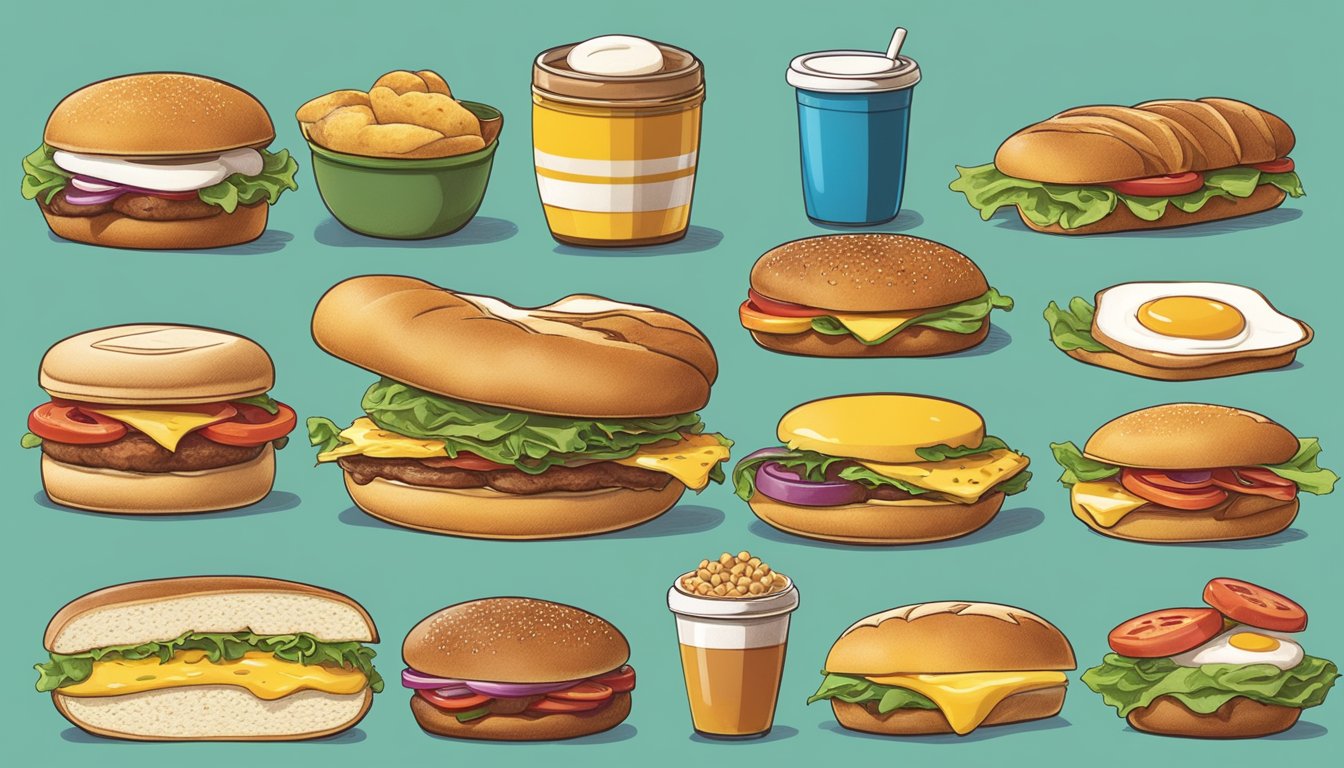- Breakfast on a bun has become a beloved morning staple for many around the world. This handheld meal combines the convenience of portability with the satisfying flavors of traditional breakfast fare. The evolution of breakfast on a bun reflects changing lifestyles and culinary preferences across cultures and time periods.
The concept of breakfast sandwiches can be traced back to various global traditions. In China, steamed buns filled with savory ingredients have long been a popular morning choice. The Americas saw the development of hearty breakfast dishes that would eventually inspire modern sandwich iterations.
As societies became more fast-paced, the need for quick, portable meals grew. This demand led to the creation and popularization of breakfast sandwiches in various forms, from simple egg and cheese combinations to more elaborate concoctions featuring regional specialties. Today, breakfast on a bun continues to adapt, incorporating diverse flavors and catering to different dietary preferences.
Historical Development of Breakfast

Breakfast has undergone significant transformations throughout human history. Ancient civilizations laid the foundations for morning meals, while later societal shifts and technological advancements reshaped breakfast habits globally.
Breakfast in Ancient Civilizations
Ancient Egyptians started their days with simple fare like bread, beer, and onions. In Greece and Rome, breakfast typically consisted of bread dipped in wine. These early morning meals provided sustenance for laborers and farmers.
Ancient Chinese breakfasts featured rice porridge, while in India, dishes like dosa and idli were common morning foods. Mayans and Aztecs consumed corn tortillas with beans or eggs to start their day.
As civilizations advanced, breakfast habits evolved to reflect cultural preferences and available ingredients. The meal gained importance as societies recognized its role in fueling daily activities.
Impact of the Industrial Revolution
The Industrial Revolution dramatically altered breakfast routines. As work schedules became more regimented, the need for a quick, energy-rich morning meal grew.
Urbanization led to the rise of bakeries and cafes, making pastries and coffee more accessible. The invention of canning and refrigeration expanded breakfast options, allowing for greater variety and convenience.
Mass production techniques enabled the creation of pre-packaged breakfast foods. This shift made morning meals faster and easier to prepare, catering to the needs of a growing workforce.
The Birth of Breakfast Cereals
In the late 19th century, breakfast cereals emerged as a revolutionary morning food. Dr. John Harvey Kellogg, seeking to create a healthy, easy-to-digest meal, invented corn flakes in 1894.
Cereal production quickly industrialized, with companies like Post and Quaker Oats joining the market. Clever marketing campaigns promoted cereals as nutritious and convenient alternatives to traditional breakfasts.
The addition of sugar and flavoring made cereals more appealing, especially to children. By the mid-20th century, breakfast cereals had become a staple in many households, reshaping morning eating habits worldwide.
Breakfast Foods and Their Evolution
Breakfast foods have undergone significant changes throughout history, reflecting shifts in cultural preferences, agricultural practices, and technological advancements. The journey from simple grains to elaborate morning meals showcases humanity’s culinary creativity and adaptability.
From Grains to Cereal
Ancient civilizations relied heavily on grains for their morning sustenance. Porridge made from oats, barley, or wheat was a common breakfast in many cultures. As time progressed, these grain-based meals evolved into more refined forms.
The invention of cold breakfast cereals in the late 19th century revolutionized morning routines. John Harvey Kellogg created corn flakes in 1894, paving the way for a new breakfast industry. Cereals quickly gained popularity due to their convenience and long shelf life.
Modern cereals often include added ingredients like honey, raisins, and other dried fruits for flavor and nutritional value. Some brands focus on whole grains and reduced sugar content to meet growing health consciousness.
The Rise of Breakfast Pastries
Sweet breakfast pastries emerged as popular morning options in many cultures. Cinnamon rolls and sticky buns became beloved treats, combining the comfort of bread with indulgent sweetness.
Cinnamon, a key ingredient in many breakfast pastries, has been prized for centuries for its distinctive flavor and aroma. National Cinnamon Bun Day, celebrated in Sweden on October 4th, highlights the pastry’s cultural significance.
Pancakes, another breakfast staple, have a long history dating back to ancient civilizations. They’ve evolved from simple flatbreads to fluffy stacks often served with butter and maple syrup.
Diverse Breakfast Traditions
Breakfast traditions vary widely across cultures, reflecting local ingredients and customs. The American breakfast often includes eggs, bacon, toast, and coffee – a combination that gained popularity in the 20th century.
In contrast, traditional Japanese breakfasts might feature rice, miso soup, and grilled fish. Middle Eastern breakfasts often include pita bread, hummus, and fava beans.
Many cultures have their unique breakfast specialties:
- England: Full English breakfast with eggs, bacon, sausages, baked beans, and toast
- Mexico: Huevos rancheros or chilaquiles
- India: Dosas or idli with chutney and sambar
These diverse traditions highlight the rich tapestry of global breakfast cuisines.
The Making of a Breakfast Staple
Breakfast sandwiches have become a beloved morning meal option, combining convenience and flavor. Their evolution reflects changing tastes and lifestyles, with global influences and creative use of leftovers shaping their development.
Evolution of the Breakfast Sandwich
The breakfast sandwich emerged as a portable solution for busy mornings. Early versions often featured eggs, cheese, and meat between slices of bread or in a roll. In the 1970s, fast-food chains popularized these handheld meals, with McDonald’s introducing the Egg McMuffin in 1972.
As demand grew, varieties expanded. Bagels, English muffins, and croissants became popular bases. Fillings diversified to include bacon, sausage, ham, and vegetarian options. Healthier versions with egg whites and whole grain breads appeared in response to nutritional concerns.
Home cooks began recreating and innovating breakfast sandwiches, leading to gourmet versions with artisanal ingredients. The rise of brunch culture further elevated these sandwiches, inspiring creative combinations and presentation styles.
Global Influence and Fusion
Breakfast sandwiches have absorbed flavors from various cuisines. Mexican-inspired versions incorporate salsa, avocado, and chorizo. Asian influences brought about sandwiches with sriracha sauce or kimchi.
In the Middle East, breakfast pitas stuffed with falafel or shakshuka gained popularity. European cafes introduced croque madame, a French twist on the classic ham and cheese sandwich topped with a fried egg.
Fusion creations blended cultural elements, like Japanese-style tamagoyaki omelets in Western-style sandwiches. Street food vendors worldwide adapted local ingredients to create unique breakfast offerings, further diversifying the landscape of morning sandwiches.
How Leftovers Influenced Breakfast
Leftovers played a crucial role in shaping breakfast sandwiches. Resourceful cooks repurposed dinner remnants into morning meals. Leftover roast beef or chicken found new life in breakfast creations.
Thanksgiving-inspired sandwiches featuring turkey, cranberry sauce, and stuffing became popular seasonal offerings. Barbecue enthusiasts transformed leftover pulled pork into morning sandwiches with eggs and cheese.
Vegetable-based leftovers also contributed to innovative breakfast sandwiches. Grilled vegetables, potato hash, and even leftover salads were incorporated, adding nutritional value and reducing food waste. This trend aligned with growing environmental consciousness and the desire for sustainable eating habits.
Contemporary Breakfast Habits

Today’s breakfast habits reflect a blend of convenience, health consciousness, and cultural fusion. Changing lifestyles and global influences have reshaped how people start their day.
The Role of Marketing in Breakfast Choices
Marketing plays a crucial role in shaping breakfast preferences. Cereal companies invest heavily in ads targeting children and adults alike. Colorful packaging and cartoon mascots entice younger consumers. Health-focused campaigns promote whole grains and added vitamins.
Coffee chains market specialty drinks as morning pick-me-ups. They create seasonal flavors to generate buzz and drive sales. Fast food restaurants advertise breakfast sandwiches as quick, portable options for busy professionals.
Social media influencers showcase photogenic breakfast bowls and smoothies. This drives trends in healthy eating and aesthetically pleasing meals.
The Weekend Phenomenon: Brunch
Brunch has become a popular weekend ritual in many urban areas. It combines breakfast and lunch, typically served from late morning to early afternoon.
Restaurants offer diverse brunch menus featuring both sweet and savory options. Classic choices include eggs benedict, pancakes, and avocado toast. Many establishments add unique twists to traditional dishes.
Bottomless mimosas and bloody marys are common brunch drink specials. These attract social groups looking to relax and catch up over a leisurely meal.
Brunch culture has sparked new businesses like mobile brunch trucks and brunch-focused cookbooks. It’s also become a popular theme for social gatherings and special events.
Health and Nutrition

The breakfast sandwich has become a staple of modern morning meals, combining convenience with nutritional elements. Its composition typically includes protein, carbohydrates, and fats, providing a balance of macronutrients to start the day.
Protein sources like eggs, cheese, or lean meats offer essential amino acids for muscle repair and satiety. Whole grain buns or English muffins contribute fiber and complex carbohydrates, supporting digestive health and sustained energy release.
However, some breakfast sandwiches can be high in saturated fats and sodium, particularly those featuring processed meats. To optimize nutritional value, choose lean proteins and whole grain options.
Many breakfast sandwiches incorporate vegetables like tomatoes or spinach, boosting vitamin and mineral content. These additions support immune function and overall health.
Portion size plays a crucial role in the nutritional impact of breakfast sandwiches. Moderation is key to maintaining a balanced diet and avoiding excessive calorie intake.
Research suggests that consuming a protein-rich breakfast may help regulate appetite throughout the day. This could potentially aid in weight management and promote healthier dietary habits.




